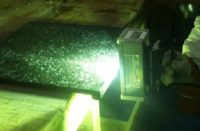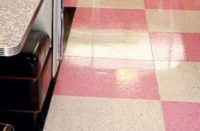The world we live and work in moves so fast, just going through the motions seems to have become the norm. Taking time to really understand how or why a product works is not even on the radar screen. Over the last 12 years, I have seen this lack of knowing how and why show up as a common thread in my conversations with installers when troubleshooting problems. I have always been an inquisitive person, and have made it a central point of my trainings, presentations and conversations to not only provide answers, but to try to explain, in everyday language, the process of why and how a product or process works, and therefore, why it is important to follow all the steps outlined in the application guidelines.
With that in mind, give me a few minutes of your busy day, and let’s dig a little deeper into the three most common concepts that affect decorative concrete applications. Not surprisingly, these concepts factor into most of the problems we encounter in the decorative industry.
If you have spent any time in our industry, I am sure you have either heard or said one of the following statements: “It all wiped off, and we were back to gray concrete!” “It was flaking off!” “I could scratch the sealer with my fingernail!” “The concrete has been down for months, but the color just keeps coming off!” What do all these statements have in common? Yes, the title of the article says it all – porosity, penetration and adhesion.
Porosity – Will the material absorb into a substrate?
Penetration – Did it absorb into a substrate?
Adhesion – Did it stick to a substrate, and how well?
These three very basic questions are the keys to success for almost every decorative finish. You will find references made to one or all of these three terms in almost every piece of decorative concrete product literature or installation guide. Since they are such common and critical factors to successful installation, I want to spend some time simplifying these terms and processes, and explaining why they are so critical to long-term installation success.
If we look up the definition of the word “porosity,” we find the following: Porosity is a measure of the void spaces in a material, and it is measured as a fraction or a percentage. The term “porosity” is used in multiple fields, including ceramics, metallurgy, materials, manufacturing, earth sciences and construction. OK, so what exactly does that mean, and how does it relate to decorative concrete? Anytime a stain, dye, sealer, coating, primer, underlayment or overlay is applied, porosity comes into play. Specific to our industry, porosity in decorative concrete is a measure of how much stain, dye or coating will soak into the concrete, and how fast. Using a simple analogy, imagine the concrete in question as a series of rooms with doors. How big those doors are, how many are open, how open each door is, and how big the room is on the other side of the door will determine the porosity and how successful the stain, dye or coating application will be. In a perfect world, all those doors would be big and wide open, and the rooms on the other side would be large and empty, connecting to each and every other room in the concrete slab. We don’t live or work in a perfect world, which is why surface analysis and surface preparation are so very important in any application. This includes, but is not limited to, water tests, moisture vapor transmission testing, sanding, grinding, acid etching and scarifying.
These days, we see concrete that is very dense, finished very tight, chemically modified and/or membrane cured. All of these factors create better concrete, but also close those doors and fill the rooms. This means that surfaces where stains, dyes, sealers or overlays are being applied MUST be prepared. To once again simplify, we need to make sure enough doors are open and the openings are big enough to allow the product being applied to get in.
Now that we all have a better understanding of what porosity is and why porosity is so important, let’s look at the next process, penetration. The two really go hand in hand, and in a lot of instances cannot be separated. Once again, let’s use our analogy of rooms and doors. If porosity is a measure of how much and how fast the stain, dye, sealer, or overlay is going to get into spaces through all those doors, penetration is the measure of how deep or far the stain, dye, sealer or overlay will penetrate. If the rooms behind the doors are small or full (of chemicals, dirt or some other contaminant), the ability of any applied product to penetrate will be affected. Penetration is measured in terms of depth of penetration and the percentage of the amount of the material that penetrated into the surface.
There should now be more clarity as to how porosity and penetration go hand in hand. It does not really matter how empty those rooms are if the doors are closed or so small nothing can squeeze through the opening. On the other hand, the doors can be wide open, but if the rooms are full, the material is not going to penetrate very deeply. Understanding porosity and penetration is especially important when applying stains and sealers.
The other things to consider are the particle size of the colorant (stains are much larger then dyes) and the percentage of solids in the sealer (low solids requires fewer open doors, while high solids requires lots of open doors). All of this information needs to be taken into consideration when determining the type of surface preparation that will be used.
The last of the three critical processes is adhesion. Simply put, adhesion is a measure of how well one material sticks to another. There are two forms of adhesion, chemical and mechanical. Some materials adhere to another based solely on one method of adhesion, while others rely on both methods.
Chemical adhesion is all about chemistry — adhesion at the molecular level, where two molecules become one by the process of sharing electrons or electric charges. Chemical bonds have different strengths, and chemical adhesion is the lesser of the two forms of adhesion. A great way to get a better understanding of chemical adhesion is to watch what happens when two drops of water come in close proximity to each other. They literally jump together and become one — voila! Chemical adhesion at work.
Mechanical adhesion, which is the more common form of adhesion when applying decorative products, is all about filling voids. Going back to our door and room analogy, I think you can now see why it is so important for those doors to not only be as open (porosity) as possible, but lead to rooms as big and empty (penetration) as possible. When a stain, dye, sealer or overlay can get into those rooms, fill them, get hard, and literally lock itself in place, that is adhesion.
Now that we have simplified the three processes, it should be clear how they work hand in hand. If you only take one thing away from this article, let it be that every job is different, and you can’t expect a stain, dye or sealer to work without some type of surface preparation. Always do a sample, and use what you have learned to make sure the surface is porous, the product is penetrating, and you have achieved proper adhesion.















